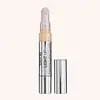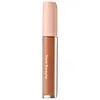ISADORA Light Up Brightening Cushion Concealer Versus Rare Beauty Positive Light Under Eye Brightener
What's inside
What's inside
 Key Ingredients
Key Ingredients

 Benefits
Benefits

 Concerns
Concerns

 Ingredients Side-by-side
Ingredients Side-by-side

Water
Skin ConditioningCyclopentasiloxane
EmollientMica
Cosmetic ColorantCyclohexasiloxane
EmollientButylene Glycol
HumectantPEG-10 Dimethicone
Skin ConditioningGlycerin
HumectantKaolin
AbrasiveDipentaerythrityl Pentaisononanoate
EmollientPhenyl Trimethicone
Skin ConditioningCetyl PEG/PPG-10/1 Dimethicone
EmulsifyingSodium Chloride
MaskingDisteardimonium Hectorite
StabilisingTrimethylsiloxysilicate
EmollientBenzyl Alcohol
PerfumingPropanediol
SolventTriethoxycaprylylsilane
Magnesium Stearate
Cosmetic ColorantTalc
AbrasiveAluminum Hydroxide
EmollientSalicylic Acid
MaskingTin Oxide
AbrasiveSorbic Acid
PreservativeHydrogen Dimethicone
Vitis Vinifera Juice Extract
AntioxidantCI 77891
Cosmetic ColorantCI 77491
Cosmetic ColorantCI 77492
Cosmetic ColorantWater, Cyclopentasiloxane, Mica, Cyclohexasiloxane, Butylene Glycol, PEG-10 Dimethicone, Glycerin, Kaolin, Dipentaerythrityl Pentaisononanoate, Phenyl Trimethicone, Cetyl PEG/PPG-10/1 Dimethicone, Sodium Chloride, Disteardimonium Hectorite, Trimethylsiloxysilicate, Benzyl Alcohol, Propanediol, Triethoxycaprylylsilane, Magnesium Stearate, Talc, Aluminum Hydroxide, Salicylic Acid, Tin Oxide, Sorbic Acid, Hydrogen Dimethicone, Vitis Vinifera Juice Extract, CI 77891, CI 77491, CI 77492
Water
Skin ConditioningDipropylheptyl Carbonate
EmollientHydrogenated Didecene
Skin ConditioningGlycerin
HumectantPhenyl Trimethicone
Skin ConditioningCetyl PEG/PPG-10/1 Dimethicone
EmulsifyingPvp
Emulsion StabilisingLauryl PEG-9 Polydimethylsiloxyethyl Dimethicone
Skin ConditioningButylene Glycol
HumectantSodium Chloride
MaskingGlyceryl Behenate
EmollientSilica
AbrasiveDisteardimonium Hectorite
StabilisingHydroxyacetophenone
AntioxidantHelianthus Annuus Seed Oil
EmollientMethicone
Emollient1,2-Hexanediol
Skin ConditioningCaprylyl Glycol
EmollientTocopheryl Acetate
AntioxidantDimethicone/Vinyl Dimethicone Crosspolymer
Skin ConditioningTrisodium Ethylenediamine Disuccinate
Paeonia Lactiflora Root Extract
Skin ConditioningTocopherol
AntioxidantTalc
AbrasiveGardenia Florida Fruit Extract
Skin ConditioningNelumbo Nucifera Flower Extract
Skin ConditioningNymphaea Odorata Root Extract
RefreshingVitex Agnus-Castus Extract
AstringentIron Oxides
CI 77163
Cosmetic ColorantCI 77891
Cosmetic ColorantWater, Dipropylheptyl Carbonate, Hydrogenated Didecene, Glycerin, Phenyl Trimethicone, Cetyl PEG/PPG-10/1 Dimethicone, Pvp, Lauryl PEG-9 Polydimethylsiloxyethyl Dimethicone, Butylene Glycol, Sodium Chloride, Glyceryl Behenate, Silica, Disteardimonium Hectorite, Hydroxyacetophenone, Helianthus Annuus Seed Oil, Methicone, 1,2-Hexanediol, Caprylyl Glycol, Tocopheryl Acetate, Dimethicone/Vinyl Dimethicone Crosspolymer, Trisodium Ethylenediamine Disuccinate, Paeonia Lactiflora Root Extract, Tocopherol, Talc, Gardenia Florida Fruit Extract, Nelumbo Nucifera Flower Extract, Nymphaea Odorata Root Extract, Vitex Agnus-Castus Extract, Iron Oxides, CI 77163, CI 77891
 Reviews
Reviews

Ingredients Explained
These ingredients are found in both products.
Ingredients higher up in an ingredient list are typically present in a larger amount.
Butylene Glycol (or BG) is used within cosmetic products for a few different reasons:
Overall, Butylene Glycol is a safe and well-rounded ingredient that works well with other ingredients.
Though this ingredient works well with most skin types, some people with sensitive skin may experience a reaction such as allergic rashes, closed comedones, or itchiness.
Learn more about Butylene GlycolThis ingredient is a high molecular weight silicone. It has emulsifying and skin conditioning properties.
Ci 77891 is a white pigment from Titanium dioxide. It is naturally found in minerals such as rutile and ilmenite.
It's main function is to add a white color to cosmetics. It can also be mixed with other colors to create different shades.
Ci 77891 is commonly found in sunscreens due to its ability to block UV rays.
Learn more about CI 77891Disteardimonium Hectorite comes from the clay mineral named hectorite. It is used to add thickness to a product.
It can also help stabilize a product by helping to disperse other ingredients.
Hectorite is a rare, white clay mineral.
Learn more about Disteardimonium HectoriteGlycerin is already naturally found in your skin. It helps moisturize and protect your skin.
A study from 2016 found glycerin to be more effective as a humectant than AHAs and hyaluronic acid.
As a humectant, it helps the skin stay hydrated by pulling moisture to your skin. The low molecular weight of glycerin allows it to pull moisture into the deeper layers of your skin.
Hydrated skin improves your skin barrier; Your skin barrier helps protect against irritants and bacteria.
Glycerin has also been found to have antimicrobial and antiviral properties. Due to these properties, glycerin is often used in wound and burn treatments.
In cosmetics, glycerin is usually derived from plants such as soybean or palm. However, it can also be sourced from animals, such as tallow or animal fat.
This ingredient is organic, colorless, odorless, and non-toxic.
Glycerin is the name for this ingredient in American English. British English uses Glycerol/Glycerine.
Learn more about GlycerinPhenyl Trimethicone is a silicon-based polymer. It is derived from silica.
Phenyl Trimethicone is used as an emollient and prevents products from foaming.
As an emollient, it helps trap moisture in the skin. It is considered an occlusive.
Learn more about Phenyl TrimethiconeChances are, you eat sodium chloride every day. Sodium Chloride is also known as table salt.
This ingredient has many purposes in skincare: thickener, emulsifier, and exfoliator.
You'll most likely find this ingredient in cleansers where it is used to create a gel-like texture. As an emulsifier, it also prevents ingredients from separating.
There is much debate on whether this ingredient is comedogenic. The short answer - comedogenic ratings don't tell the whole story. Learn more about comegodenic ratings here.
The concensus about this ingredient causing acne seems to be divided. Research is needed to understand if this ingredient does cause acne.
Scrubs may use salt as the primary exfoliating ingredient.
Learn more about Sodium ChlorideTalc is a clay mineral. It helps absorb moisture and improve the texture of products. Like other types of clay, Talc can have a slight exfoliating effect on skin. Talc can be added to increase the volume of products.
Some Baby powders are made by combining talc with corn starch. The word "talc" comes from Latin and originates from Arabic. Talc is a mineral commonly found throughout the world.
If you have any concerns about using talc, we recommend checking out the FDA's official page.
Learn more about TalcWater. It's the most common cosmetic ingredient of all. You'll usually see it at the top of ingredient lists, meaning that it makes up the largest part of the product.
So why is it so popular? Water most often acts as a solvent - this means that it helps dissolve other ingredients into the formulation.
You'll also recognize water as that liquid we all need to stay alive. If you see this, drink a glass of water. Stay hydrated!
Learn more about Water